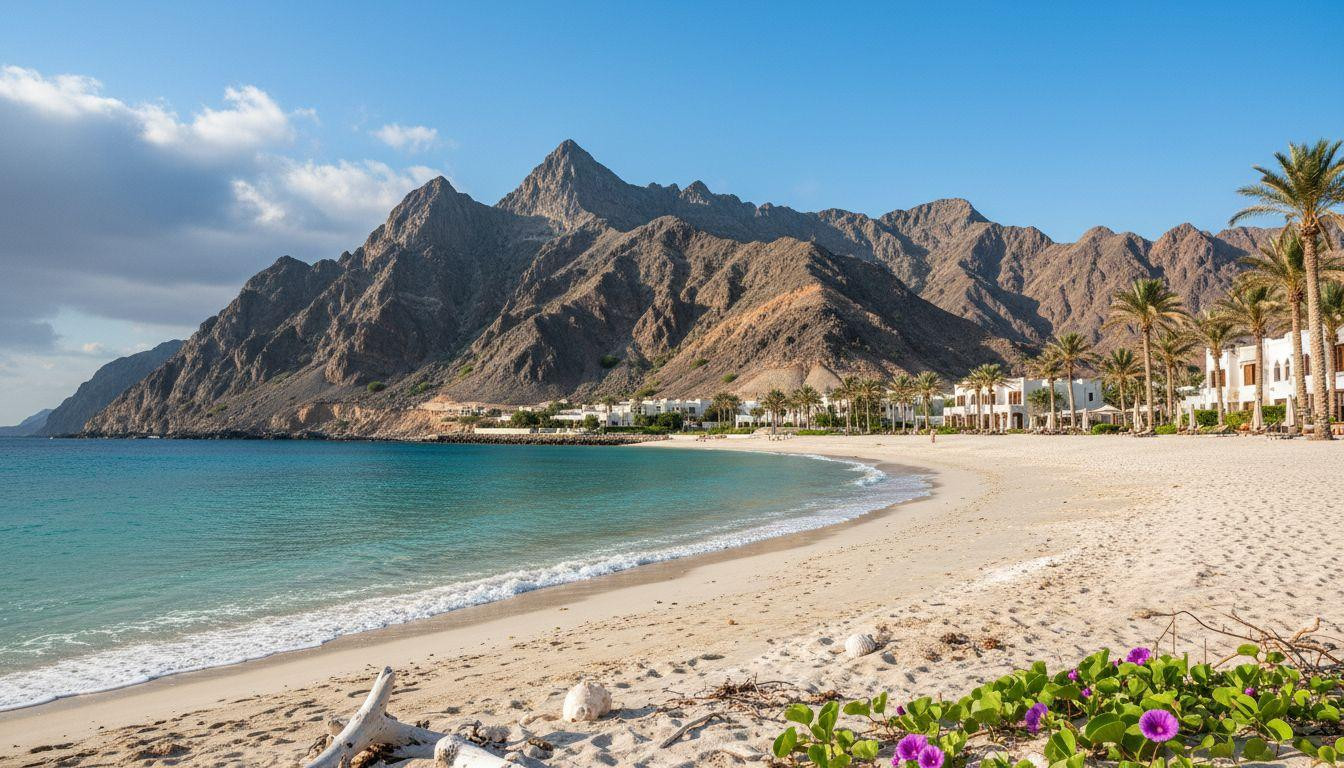Dubai’s beaches draw 16 million visitors yearly, packing shores with $500-per-night price tags and advance reservations required just to claim a spot on the sand. Just 280 miles southeast across the Gulf, Muscat delivers the same turquoise waters and luxury hospitality at prices 40% lower, with beaches so empty you’ll wonder where everyone went.
The flight between these Gulf capitals takes barely an hour. Yet stepping off the plane in Muscat feels like entering a parallel universe where luxury means space to breathe rather than Instagram-worthy crowds.
Why Dubai’s luxury beach scene feels overwhelming
Dubai’s winter season transforms the emirate into a glittering playground that never sleeps. Beach clubs at Jumeirah require bookings weeks ahead for November weekends. Hotel rates at premium properties like Atlantis The Palm soar past $600 nightly during peak months.
The city’s 30 miles of developed coastline accommodate millions of visitors packed into resort pools and organized beach areas. Even private hotel beaches feel crowded, with towel-to-towel density that rivals Mediterranean summer hotspots.
The cost of famous shores
Dubai’s reputation comes with premium pricing that reflects its global brand. Mid-range beachfront dining averages $35-50 per person, while desert safari experiences command $80-120 for standard packages. The city’s success has inflated every aspect of the visitor experience.
Meet Muscat’s pristine Gulf coast
Muscat welcomes just 3 million annual visitors, creating an atmosphere of exclusive tranquility that Dubai lost years ago. Al Bustan Palace, a Ritz-Carlton property, offers the same luxury standards as Dubai’s finest hotels but at rates averaging $350-450 per night during peak season.
The Chedi Muscat spreads across pristine beachfront with private access to soft white sand. Jumeirah Muscat Bay nestles between the Hajar Mountains and Gulf waters, creating a natural amphitheater that Dubai’s flat coastline cannot match.
White sand backed by mountains
Muscat’s geography creates postcard scenes impossible in Dubai. The Hajar Mountains rise directly behind coastal resorts, their rocky peaks catching sunrise light while guests enjoy morning coffee on empty beaches. Water temperatures hover around 75-80°F from November through March, identical to Dubai but without the crowds.
The 40% luxury discount
Numbers tell Muscat’s compelling story. Luxury accommodations cost significantly less than comparable Gulf destinations, with five-star properties averaging $300-450 versus Dubai’s $500-700 range. Restaurant meals at hotel properties cost $15-25 compared to Dubai’s $35-50 averages.
Desert experiences in Oman’s Wahiba Sands run $200-400 for luxury camping, including traditional Omani meals and stargazing sessions. Similar experiences in Dubai command $400-600 for comparable quality.
What Muscat offers Dubai cannot
Muscat preserves 5,000 years of frankincense trading heritage through active markets and cultural experiences. The Muttrah Souk operates as it has for centuries, selling traditional spices, textiles, and silver jewelry without tourist markup pricing that plagues Dubai’s commercial districts.
Oman deliberately limits high-rise development, maintaining architectural harmony that preserves cultural authenticity over flashy spectacle. Buildings rarely exceed six stories, allowing unobstructed mountain and ocean views from most hotels.
Desert meets culture
The Royal Opera House Muscat offers world-class performances with tickets starting at $25, making cultural experiences accessible rather than exclusive. Camel races occur weekly during winter months, providing authentic entertainment without Dubai’s commercial overlay.
Traditional Omani hospitality includes sharing shuwa (slow-cooked lamb) and fresh seafood caught daily from Gulf waters. Hotels serve these regional specialties at prices 30-40% below Dubai’s international cuisine costs.
Authentic Omani hospitality
Local tourism development emphasizes environmental preservation and cultural respect. Desert camps offer genuine connection with traditional Bedouin culture rather than manufactured experiences designed for social media.
Hotel staff often possess generations of local knowledge, providing insights into hidden wadis (valleys), fishing villages, and mountain hiking trails that remain undiscovered by mass tourism.
Planning your Muscat escape
November through March delivers perfect weather with daytime temperatures of 66-82°F and cool evenings ideal for outdoor dining. Muscat International Airport connects to major US cities through Dubai or European hubs, adding just one stop to reach this quieter alternative.
Five days in Muscat costs what three days in Dubai demands, allowing longer stays that justify the additional travel time. Al Bustan Palace and The Chedi Muscat represent Oman’s finest accommodations, both offering beach access and mountain views that Dubai properties cannot match.
What to skip in Dubai
Muscat eliminates Dubai’s common frustrations: Burj Khalifa elevator queues, mall crowds, and beach club reservation stress. The pace here favors exploration over checking off tourist attractions, with emphasis on natural beauty rather than architectural records.
Your questions about Muscat luxury travel answered
How much cheaper is Muscat compared to Dubai for luxury travelers?
Luxury hotels in Muscat average $300-450 per night versus Dubai’s $500-700 range, representing 35-40% savings. Restaurant meals, activities, and transportation all cost proportionally less while maintaining equivalent quality standards. A five-day luxury stay in Muscat costs what three days in Dubai typically demands.
What cultural experiences does Muscat offer that Dubai lacks?
Muscat preserves active frankincense trading traditions, authentic souks without tourist pricing, and traditional Omani architecture limited to six-story buildings. The Royal Opera House offers accessible cultural programming, while desert experiences emphasize genuine Bedouin traditions rather than manufactured entertainment designed primarily for tourism.
Is Muscat’s beach quality comparable to Dubai’s famous shores?
Muscat’s beaches feature the same Gulf waters and white sand as Dubai but with dramatically fewer visitors. The Hajar Mountains create scenic backdrops impossible in Dubai’s flat terrain. Water temperatures and weather conditions remain nearly identical during the November-March peak season, but without advance reservations required for beach access.
Morning light paints Muscat’s mountains gold while waves lap empty shores where frankincense once departed for ancient Rome. Here, luxury means having space to breathe rather than fighting crowds for the perfect photo.
